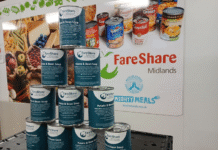In November 2019, at the opening of the brand new Constantia Ecoflex plant near Ahmedabad, we first met Dr Achim Grefenstein. While seated together at the event, Dr. Achim Grefenstein, senior vice-president of R&D at Constantia Flexibles and member of the Advisory Board of RecyClass, who developed the innovative EcoLam laminates in close collaboration with the Indian team, said to us, “Ecolam is the first high barrier flexible packaging that combines the resource-efficiency of plastic with recyclability back into new packaging films.”
As we have written earlier, Constantia’s EcoLam is a lightweight mono-PE lamination suitable for a great variety of packaging applications. Due to its mono-material structure, it is fully recyclable, and its carbon footprint is approximately 32% lower than that of comparable products. The EcoLam family comes in different barrier grades (EcoLam, EcoLamPlus, EcoLamHighPlus) to deliver the barrier needs for a diversified range of products.
A few months after the plant commissioning, Constantia Ecoflex installed a specially designed narrow-width Expert K5 vacuum metallizer to help produce its Ultra High Barrier PE film meeting market requirements for a sustainable, fully recyclable flexible packaging solution as a replacement for aluminum foil. This technology, together with all the other technology at the plant, including the 7-layer blown film line with MDO, contributed to the creation of what was said to be the world’s first high barrier PE recyclable solution in Constantia’s EcoLamHighPlus laminates, which also received RecyClass approval in Europe. The 24,500 square meter Ecoflex plant in Ahmedabad was planned right from the start to supply customers not only in India but across the world.
Almost three years later, at the Elite Conference in Mumbai in early September, Dr. Grefenstein made an important presentation that addressed some of the controversies that the Indian flexible packaging industry now faces. His presentation began with a snapshot outline of the various methods of waste collection, sorting, and recycling in practice in developed and emerging economies, including India, and also an insight into the levels of regulations and compliance deadlines. He went on to present the recycling guidelines for flexible PP and PE films stating the clear preference in Europe (and increasingly around the world) for mono-materials. “Even strong support for mixed PO has now been stopped by Ceflex,” he said, adding that “the latest guidelines of the Circular Plastics Alliance request that inks and adhesives should be thermally stable to survive the recycling process.”
In a subsequent conversation with Dr. Grefenstein over the web in mid-September, we had an opportunity to review some of the discussions that took place in Mumbai. We tried to better understand his presentation and his views as a scientist on the information projected at the conference, some of which by various speakers were certainly disputable or controversial.
Edited excerpts follow.
Naresh Khanna – Dr. Grefenstein, as we heard some contrary or at least confusing views in Mumbai about the recycling of mixed plastics, tell us will chemical recycling of mixed plastics or even polyester work?
Dr. Grefenstein – Chemical recycling of pure polyester will work but when it is mixed with several other materials such as ET lacquers, sealable and shrinkable polyester, it will not. None of these processes is waste neutral. When we first started looking at recyclables at Constantia Flexibles, we also looked at all materials, including polyester and even polyester with lower melt temperatures such as PET G. But even PET G is not mixable for recyclability, even with PET A.
The challenges are to create flexible packaging that is not just recyclable but laterally recyclable into flexible packaging materials or materials of equivalent or nearly equivalent value. On the other hand, polyolefins in India will be collected and these are recyclable. The majority of flexibles should go back to flexible packaging. We are working on using thermally stable inks so that the recyclates can be used at least for producing films for the inside layer of flexible packaging. It is similar to the discussion in Europe about five years ago.
NK – On the other hand, Dr. Grefenstein did you see an increased seriousness in the recent Elite conference about PE blown film produced with MDO since several suppliers also talked about it? Did you sense a gradual shift in the discussion toward monomers? What about biodegradable films?
Dr. Grefenstein – “Yes, that’s a good way to put it, that there seems to be a gradual shift in the thinking about monomaterials and their recyclability. I have never before heard so many voices of different presenters that monomer is better than mixed plastics – in one place. Overall, the situation is similar to the earlier discussions in Europe, which were also very controversial. It took some time for the ideas of mixed plastic to be relegated and this happened when some scientific persons like me and the polymer producers spoke up.
However, there was some confusion at the Mumbai conference about biodegradable films – a subject that came up several times. It was even mentioned that the Indian government may be enacting regulations for encouraging these and some speakers spoke about additives to make films biodegradable. In my opinion, they are hoping that by some miracle or by the use of an additive, some films will become biodegradable. This is a very bad idea first of all because to many persons biodegradable only means fragments that last forever and can destroy the land.
Secondly, by using these additives, the so-called biodegradable films will also no longer be recyclable. They cannot even be recycled into many useful films like those used in Europe for agricultural films for greenhouses for instance. As I said in Mumbai, biodegradables will remain restricted to applications where recycling is difficult and where dedicated recycling streams can be created at end-of-life.
NK– What is the progress of your Ecoflex plant in India, which was meant to be a pilot plant? Has it led to similar plants being built elsewhere?

Dr. Grefenstein – Yes, thanks to the production capabilities in India over the past two years, we initially limited the supply for local use and used the supply to open up markets in Europe for the EcoLam series of flexible materials. For European customers, we have developed supplier partners with similar lines under license and now, even as we speak, we are building a bigger and similar line in our main plant in Pirk in Southern Germany.
At the same time, the Ahmedabad plant has gained some traction in India but because of the laws, which are not so clear, it could be faster. That plant will continue to export its recyclable materials to designated markets that are assigned to it.
NK – Did you also notice that there were many more recycling companies in Mumbai this time and also that collaboration was one of the words that several suppliers used in their presentations?
Dr. Grefenstein – Yes that is our experience at Constantia Flexibles also that we have several collaborative projects ongoing with many companies and suppliers. The big resin companies worldwide are looking at the recycling business with both mechanical and chemical recycling. Companies such as Borealis and Dow are both setting up and investing in their recycling plants or collaborations with others or joint ventures with other companies. And at Constantia Flexibles, we firmly believe that the definition of what is recyclable has to include the recyclers. And it is clear that they prefer monomer materials and within those, there is a clear preference for PE.
NK – What is the status of the CEFLEX rules for 2025? Will there be any delay in their implementation?
Dr. Grefenstein – Constantia Flexibles is ready for CEFLEX. We are not only compliant with the CEFLEX, which is a bit softer, but we are also compliant with ReCyclass as of 2019. We also have a special sustainability certification for our pharmaceutical packaging materials.
Actually, in Europe, there is an ongoing discussion about a packaging waste directive which is also discussed as not just a recommendation but a regulation or directive. As chairman of the Plastic Recyclers Association, I know that if we had to specify different waste streams it would be a nightmare – it must be clear that whatever waste would come, it would be harmonized.
The final version of the European Commission packaging waste directive should (after some postponements) be issued by the end of this year. What they have not changed are two deadlines. By 2025, all European member states are obliged to automate their EPR rates and finalize what the packaging producer has to pay for financing the recycling. This will be moderated by their recyclability. This means that the non-recyclable or less recyclable packaging producer has to pay more than the well-recyclable material producer. That happens by 2025.
The second deadline according to the recycling guidelines is that the packaging under the red category, which means the material that cannot be recycled, must be met with complete bans by 2030.
IndiFoodBev — authentic, impactful and influential
An English-language food and beverage processing and packaging industry B2B platform in print and web, IndiFoodBev is in its third year of publication. It is said that the Indian food and beverage industries represent approximately US$ 900 billion in revenues which implies more than 20% of the country’s GDP. Eliminating the wastage on the farmside can help to deliver more protein to a higher number of the population apart from generating sizable exports. The savings in soil, seeds, water, fertilizer, energy and ultimately food and nutrition could be the most immense contribution that country is poised to make to the moderation of climate change.
To improve your marketing and grow sales to the food and beverage processing and packaging industry, talk to us. Our research and consulting company IppStar [www.ippstar.org] can assess your potential and addressable markets in light of the competition. We can discuss marketing, communication, and sales strategies for market entry and growth.
Suppliers and service providers with a strategy and budget for targeted marketing can discuss using our hybrid print, web, video, and social media channels to create brand recognition linked to market relevance. Our technical writers are ready to meet you and your customers for content.
The second largest producer of fruit and vegetables in the world is continuously expanding processing capacities and delivery systems with appropriate innovative technologies. We cover product and consumer trends, nutrition, processing, research, equipment and packaging from farm to thali. Get our 2025 media kit and recalibrate your role in this dynamic market. Enhance your visibility and relevance to existing markets and turn potential customers into conversations. Ask for a sample copy of our bi-monthly in print or our weekly IndiFoodBev eZine each Wednesday.
For editorial info@ippgroup.in — for advertisement ads1@ippgroup.in and for subscriptions subscription@ippgroup.in
Naresh Khanna – 10 February 2025
Subscribe Now











